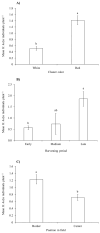Seasonal Dynamics and Damage of Halyomorpha halys in Italian Vineyards
- PMID: 38921094
- PMCID: PMC11203982
- DOI: 10.3390/insects15060378
Seasonal Dynamics and Damage of Halyomorpha halys in Italian Vineyards
Abstract
The brown marmorated stink bug, Halyomorpha halys (Stål) (Hemiptera: Pentatomidae), is an invasive polyphagous pest often observed in vineyards. In Europe, a gap needs to be filled in the knowledge on H. halys seasonal dynamics and damage on grapes. With this study, we described the seasonal dynamics of H. halys and its distribution in multi-cultivar vineyards, and we evaluated the damage on grape clusters induced by different pest densities. In vineyards, the seasonal occurrence of H. halys varied across time and grape cultivars, and the pest was more abundant on Cabernet Franc, Merlot and, to a lesser extent, Pinot gris. Moreover, higher densities of H. halys were found on red berry cultivars than on white ones, and on cultivars ripening late in the season. An edge effect was also detected in pest distribution within vineyards, with more stink bugs observed in the borders. In the study on pest infestation density, H. halys caused damage on berries, showing differences in susceptibility among different cultivars and with regard to the time of infestation (i.e., plant phenological stages). Halyomorpha halys infestation induced an increase in Botrytis cinerea and sour rot incidence, which probably represents the main issue related to the impact of brown marmorated stink bug on grapevine.
Keywords: Botrytis cinerea; IPM; Italy; Vitis vinifera; brown marmorated stink bug; cultivars; grapevine; grey mold; pathogen; sour rot.
Conflict of interest statement
The authors declare no conflicts of interest.
Figures














References
-
- OIV State of the World Wine and Wine Sector in 2022. [(accessed on 11 January 2024)]. Available online: https://www.oiv.int/sites/default/files/documents/OIV_State_of_the_world....
-
- Fregoni M. Viticoltura di Qualità. Edizioni L’Informatore Agrario S.r.l.; Piacenza, Italy: 1998.
-
- Raimondi S. Vite e vino nel mondo. In: Angelini R., editor. La Vite e il Vino. Coltura e Cultura, Bayer CropScience S.r.l. and ART Servizi Editoriali S.p.A.; Milan and Bologna, Italy: 2007. pp. 548–579.
-
- IWC Winegrape Production by Region. [(accessed on 11 January 2024)]. Available online: https://italianwinecentral.com/grape-production-by-region/
Grants and funding
LinkOut - more resources
Full Text Sources
Medical
Miscellaneous

